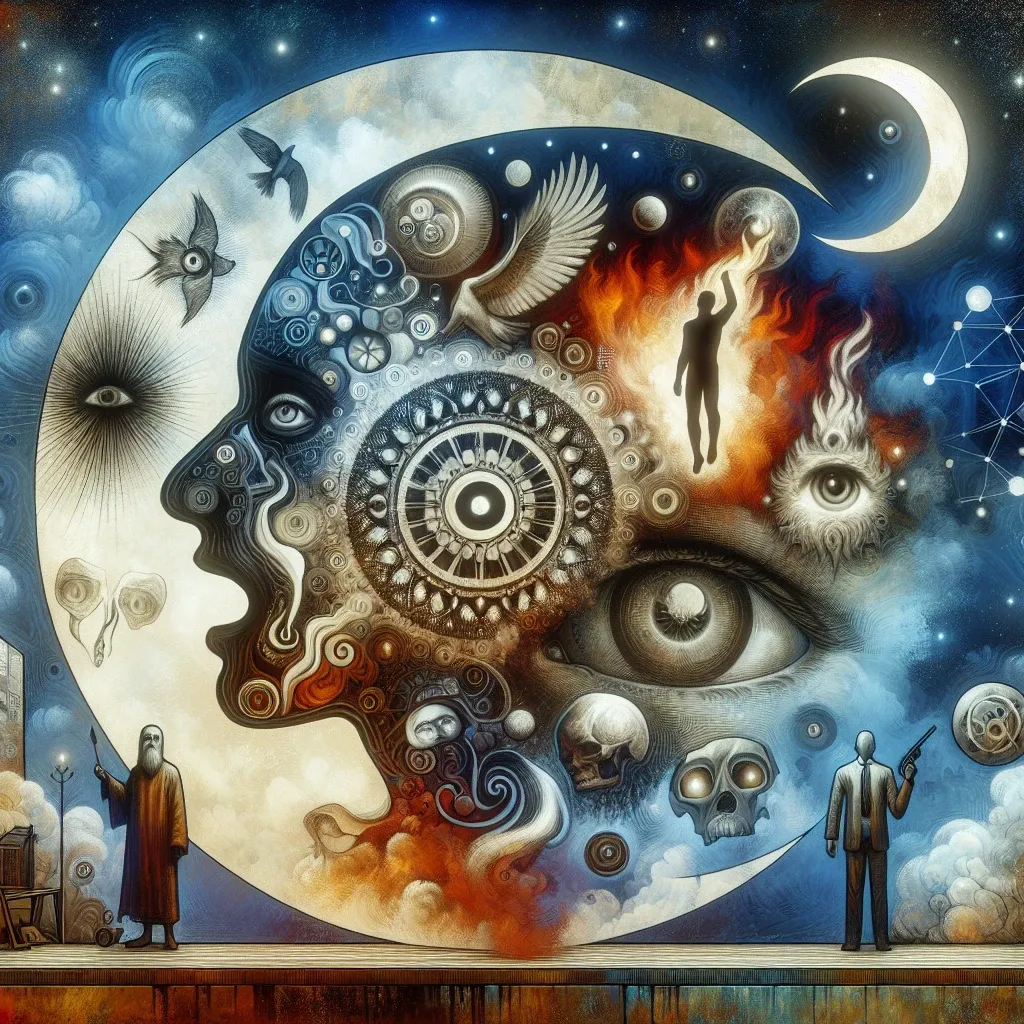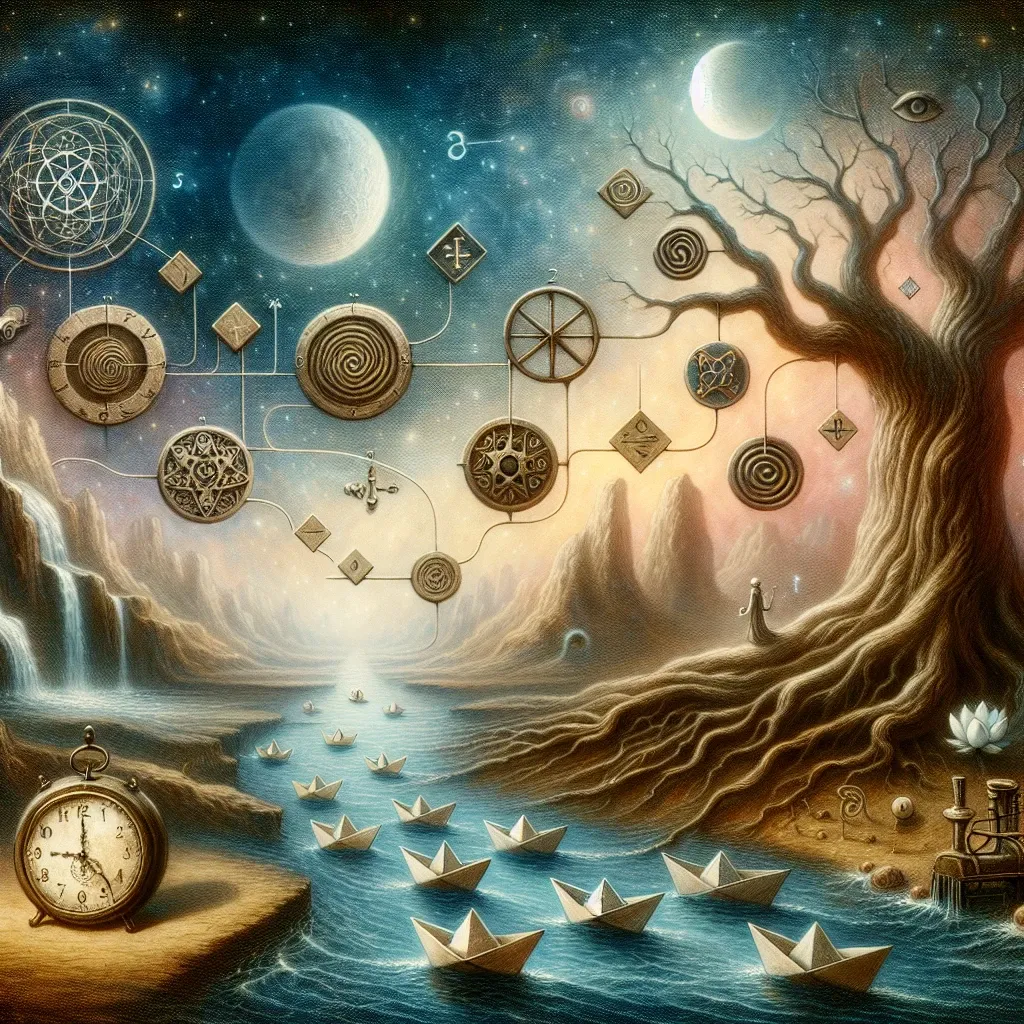Interpreting a session about subconscious exploration involves decoding the symbols and emotions connected to the mind's inner visions. The decipher Nonetheless, let's explore a general interpretation for such a dream:
**Dream Context:**
You find yourself in a therapy session, discussing your dreams with a therapist. The therapist listens carefully as you share, providing insights that resonate deeply with you. **Symbols and Interpretation:**
1. **Therapy Session:**
– A therapy session in a dream often symbolizes introspection and the desire for personal growth. It may reflect your subconscious mind's readiness to address and work through unresolved issues. Certainly, please provide the sentence you wish to have rewritten using rare literary words. **Dream Analysis:**
– Engaging in dream analysis within a dream can point to layers of self-exploration. It heralds your quest for profound significations amidst the chronicles and encounters of your existence. There's a search for understanding hidden parts of yourself. I apologize for the confusion, but it seems there was a misunderstanding. I need the original sentence to summarize. Please provide the text. **Therapist:**
– A therapist in a dream could represent guidance and wisdom. Yon simulacrum could manifest as your innate mentor, the portion of your soul that is diligent in its pursuit to expound upon convoluted feelings and predicaments. 4. **Conversed Phantasms:** The dreams within the dream highlight a meta-cognitive process where you're attempting to understand not just your subconscious, but your understanding of it. I apologize, but it seems there was an error and the sentence you wanted to be rewritten was not provided. Could you please share the sentence you wish to have rewritten using rare literary words? **Insights Provided:**
– The insights offered by the therapist in the dream might reveal your inner voice's suggestions for solving current challenges. Perchance it stands as an invocation to lend a keener auditory regard to the oracular intimations innate within oneself. 6. **Emotions Felt:**
– Paying attention to the emotions you experienced during this dream is crucial. If you felt relief or enlightenment, it might mean you're approaching a breakthrough in personal development. Anxiety might suggest apprehension about confronting the truths within you. 7. **Setting:**
– The environment of the therapy session can also hold meaning. A cozy, comfortable room might reflect a sense of security in your self-discovery journey, while a more clinical setting might indicate a need for formal support or structure. **Personal Associations:**
Consider your personal views on therapy and dream analysis. If you hold these in high regard, the dream might be affirming your belief in the therapeutic process. If you harbor incredulity or lack acquaintance with…
Introduction to Dream Analysis Therapy

An intriguing subdivision of the mind-healing disciplines, this practice explores the elaborate filigree of our slumbering sagas to elucidate At its core, it is the practice of interpreting dreams to uncover underlying emotions, desires, and insights that we may not be consciously aware of in our waking lives. The provenance of this curative methodology stretches into the antiquity of erstwhile societies that regarded oneirology as communiqués from the celestial or portents fraught with momentous import. In modern times, dream analysis gained prominence through the pioneering work of figures like Sigmund Freud and Carl Jung, who saw dreams as a direct route to the psyche's deepest recesses. The integration of this approach into psychological practice has offered a significant resource for mental health professionals. It serves as a bridge to the unconscious, allowing individuals to explore their inner narrative through the symbols and storylines that play out in their dreams. The quest inward stands to reveal enigmatic aspects of By examining the metaphors and imagery that our minds conjure up while we sleep, dream analysis therapy offers a unique lens through which we can view our inner world, revealing aspects of our personality and life experiences that might otherwise remain hidden in the subconscious.
The importance of dreams in understanding the subconscious
Upon the venerable backdrop of oneirology's legacy in the psychoanalytic domain, we proceed to consider the paramount significance of slumberous reveries in the elucidation of the subconscious mind's arcane corridors. Dreams serve as a vital communication channel between our conscious mind and the elusive depths of our subconscious. Oneiric sequences are not merely the spawn of idle fantasy or the insignificant eff Dreams can act as a reflection of our deepest fears, unspoken desires, unresolved conflicts, and unprocessed life events. They may reenact tableaux of our quotidian existence, albeit with an idiosyncratic slant—imbued with emblematic representations, allegories, and occasionally outlandish iconography that demand cogitation to decipher their import. This unique expression of the subconscious can provide insights into our psychological state that may be difficult to access through traditional conscious thought processes. The arcane depths of our subconscious, cloaked in obscurity by day, find liberation amidst nocturnal reprieves. Dreams can bypass the ego defenses that typically filter or repress certain thoughts and feelings, allowing a more honest and direct appraisal of one's inner world. Through dream analysis therapy, individuals can begin to recognize patterns and themes that recur in their dreams, which may be indicative of deeper issues or concerns that need to be addressed. Moreover, dreams can be a source of creativity, inspiration, and problem-solving. Dreams harbor the potency to coalesce reminiscences, traverse emotional landscapes, and, as hypothesized by select intellectual treatises, unravel profound conundrums of the mind. The significance of dreams in understanding the subconscious is not only rooted in their content but also in their ability to influence our emotional well-being and mental health. By engaging with dream analysis therapy, individuals can harness the instructive power of their dreams, gaining a profound awareness of their subconscious workings and, ultimately, embarking on a journey of self-discovery and personal growth.
The Theoretical Foundations of Dream Analysis
The theoretical underpinnings of subconscious exploration through dream interpretation are deeply embedded in the fertile grounds of psychoanalytic theory, shaped by contributions from leading minds in psychology. Significant psychic emanations promise insight into the inner self. They emerge instead as significant emanations of the psyche's cryptic depths, teeming with the promise of perspicacity into the esoteric mechanisms of one's interior self. Sigmund Freud, a seminal figure in psychoanalysis, proposed that our nocturnal visions act as sentinels of slumber, shielding us from internal turmoil that could interrupt our rest. He delineated the This transformation involves mechanisms such as displacement, condensation, and symbolization, which serve to disguise the true meaning of the dream. In Freud's scholarly compositions, he propounds that assiduous scrutiny permits an individual to rend the enigmatic integuments of the dream, thus disclosing the subjugated appetites and skirmishes ensconced in the penumbra of the unconscious. Carl Jung expanded on Freud's ideas by emphasizing the collective unconscious and the archetypal imagery inherent in dreams. His conviction was that nocturnal reveries could forge a link to the aggregate unconscious, a vault brimming with the collective chronicles and iconography of humankind's legacy. Jung's approach focused on the personal and collective significance of dream symbols, suggesting that they could offer a roadmap to personal individuation and psychological wholeness. In this epoch, Cognitive approaches examine how dreams may be related to memory consolidation and problem-solving, while neuroscientific studies explore the physiological aspects of dreaming and its impact on emotional regulation. Theorists grounded in existential and humanistic doctrine interpret somnial sequences as echoes resonating with the soul's current existential plight, intrinsic conundrums, and abysmal metaphysical interrogatives. These theoretical underpinnings form the backbone of dream analysis therapy, providing a multi-faceted approach to understanding the messages conveyed through dreams. Through the synthesis of these sagacious tenets, the therapeutist is equipped to sculpt an approach uniquely suited to every soul
Contemporary views on the significance of dreams in therapy
Expanding on the pioneering dogmas of Freud and Jung, contemporary ruminations concerning the utility of twilight imaginings in curative dialogues champion a more manifold and integrative stratagem for their elucidation. The field of psychology today embraces a variety of perspectives, each contributing to a more comprehensive understanding of dreams and their role in the therapeutic process. Proponents of the cognitive-behavioral schema assert that slumberous reveries serve as a tableau reflecting the ratiocinative functions and emotive disquiets of the noctambulant. Visions represent mental processing and strategizing for daily challenges. This perspective often emphasizes the functional aspects of dreaming, such as its role in memory consolidation, emotional regulation, and the rehearsal of coping strategies. Cerebral cartography has elucidated the enigmatic substrates dictating the phantasm of dreams, conspicuously during the encephalic choreography inherent in the REM phase of slumber. Advances in brain imaging technology have allowed scientists to explore the connections between dreaming and the neural substrates of emotion, learning, and memory. This study has begotten demonstrable attestation endorsing the remedial worth of oneirology, revealing how dreams may function as a vestibule to the discernment of neural substrates Humanistic and existential therapists have also contributed to contemporary views on dreams, emphasizing the personal meaning and existential significance of dream content. Seen from this angle, dreams are regarded as This approach often encourages clients to explore how their dreams relate to their sense of self, their relationships, and their place in the world. Present-day curators of the mind harmonize attentiveness and discernment exercises with the her This can foster a deeper connection with the unconscious and facilitate the integration of dream insights into conscious awareness. Current perspectives on somnial examination amidst psychotherapeutic praxis bear the hallmark of multiplicity and amalgamation. They appreciate diverse ideas while understanding unique dream complexities. This inclusive approach to dream analysis therapy allows for a rich and diverse exploration of the inner world, offering clients a powerful tool for self-discovery, healing, and personal transformation.
How Dream Analysis Therapy Works
The undertaking arises with the apprehension that each eventide fable is a distinctive and treasured correspondence from the nether regions of the mind, awaiting decryption. In the therapeutic setting, the process typically starts with the client recounting their dream in as much detail as possible. With vigilant heed, the counselor observes, often recording esoteric script, and may invite the querent to amplify upon select intricacies of the somnolent drama or to voice the emotive undertones woven throughout the dream's The therapist guides the client through an exploration of the dream's symbols, characters, and settings, asking probing questions that encourage the dreamer to consider various interpretations and personal associations. Our dialogic partnership aspires to decode the esoteric meanings Key to the process is the understanding that each dream element can have multiple layers of significance, and the therapist helps the client to navigate these complexities. Procedures like unrestrained association, permitting the client to express instinctual ruminations evoked by a somnolent totem, and magnification, where said totem is Throughout this journey into the dream world, the therapist maintains a non-judgmental and supportive stance, facilitating a safe space for the client to delve into their subconscious material. The ultimate goal of dream analysis therapy is not simply to interpret the dream but to empower the client to connect with their own inner wisdom and insights. By bringing the messages of the dream to conscious awareness, the client can gain a better understanding of their subconscious motivations, resolve internal conflicts, and move toward greater self-awareness and psychological growth.
The process of recording and discussing dreams
The process of recording and discussing nocturnal narratives is an essential component of this psychological treatment, offering a crucial step in revealing the messages from the subconscious mind. Chronicling one's nocturnal visions permits individuals to safeguard the evanescent nuances of their somnolent adventures, which are frequently prone to swift oblivion upon arousal. Clients advised to maintain bedside dream journal for recording. They should write down their dreams as soon as they awaken, capturing as much detail as possible, including the setting, characters, emotions, and even the most seemingly insignificant elements. The endeavor of documenting dreamscape meanderings enhances not just memory consolidation but also instigates sag This practice can heighten a client's awareness of their dream patterns over time, revealing recurring themes or symbols that may be significant. The nocturnal log functions as a corporeal archive, which the supplicant may present at curative convocations, offering a cornerstone for disquisition and scrutiny. During therapy sessions, the therapist invites the client to share their recorded dreams. Herein lies a duet of discovery; the discerning therapist The therapist may inquire about any associations the client has with particular aspects of the dream or if any parts of the dream relate to their waking life experiences. Therapist and supplicant alike delve into the dream's enigma, parsing its multiplex viewpoints and interpretational significances. They may explore the personal meaning of the dream for the client, as well as consider any cultural or universal symbolism that might apply. Via this scrupulous and solicitous discourse, the client is escorted to a deep understanding of the dream's veiled messages, and the manner in which these epiphanies could illuminate their life path and individual advancement. Recording and discussing dreams in this structured way within the context of therapy can be an enlightening and transformative process. The process affords one the opportunity not solely to express and elucidate the arcane phenomena of their subliminal realm but to incorporate the enlightenment of their dreamscapes into their conscious apprehension, engender
Benefits of Dream Analysis Therapy
Exploring the subconscious through dream interpretation provides numerous advantages, acting as an effective approach for those aiming to enhance self-knowledge and advance mental health. Amongst the chief merits of this remedial technique is the encouragement of inner perspicacity. By interpreting the rich tapestry of images and storylines that emerge from the subconscious during sleep, individuals can gain insights into their hidden emotions, desires, and fears. This magnified introspection can yield a panoramic discernment of one's innermost drivers and actions, promoting ontogenic progression and autophilia. Within this cerebral vocation, one discerns the propitious chance for sentient rehabilitation and the quelling of esoteric discordances. Phantasms of sleep oftentimes unmask the concealed strife and psychical scars which one might find formidable to gr By working through these dream symbols and narratives with a therapist, individuals can address and process these underlying challenges, leading to emotional catharsis and the alleviation of mental distress. Dream analysis therapy can also contribute to the development of problem-solving skills and creativity. Dreams can serve as a playground for the mind, presenting scenarios that, although sometimes bizarre or unrealistic, can inspire creative thinking and novel solutions to real-life problems. Discourse with the specters of Furthermore, dream analysis can strengthen the therapeutic relationship and enhance the therapeutic process. Unveiling Lastly, dream analysis therapy can be an enriching journey towards self-discovery and individuation. It enables entities to engage with the profoundest realms of their inner being, entailing This exploration can lead to a greater sense of wholeness and integration of the self, contributing to a richer and more meaningful life experience. In summary, dream analysis therapy can illuminate the inner world of the individual, providing valuable insights, fostering emotional healing, enhancing creativity, strengthening the therapeutic alliance, and promoting a journey of personal transformation.
Enhanced self-awareness and
Elevated cognizance of one's inner machinations emerges as a paramount advantage of such analytical curative measures, playing a critical role in individual maturation and psychic vigor. The examination of somnial visions grants voyagers a rarefied portal to survey the veiled recesses of their innermost being, excavating ponderings, passions, and drives customarily This introspective process can reveal underlying patterns of behavior, emotional responses, and core beliefs that shape one's perception of the world and interactions within it. By acknowledging these cryptic promptings of the unconscious, one may cultivate an elevated comprehension of their psyche, indispensable for effectuating deliberate metamorphoses in their existence. Self-awareness gained from dream analysis can lead to greater emotional intelligence, as individuals learn to identify and manage their emotions more effectively. The practice nurtures autarky of spirit, bestowing upon individuals the fortitude to architect their own actions and the vector of their existence. Furthermore, this enhanced self-awareness can improve relationships, both with oneself and with others. Comprehending oneiric visions may cultivate self-clemency and forbearance, as souls acknowledge the intricacy of their esoteric encounters. It can also lead to better communication and empathy in interpersonal relationships, as one becomes more attuned to the emotional undercurrents that influence interactions. In the sanctum of therapy, the sagacity reaped from oneiric scrutiny bears the potential for profound metamorphosis. With the guidance of a therapist, individuals can integrate their newfound self-awareness into their daily lives, crafting a narrative that honors both their conscious intentions and subconscious needs. This concinnity between the esoteric and exoteric selves constitutes a potent stride towards an existence of unfeigned plenitude.























